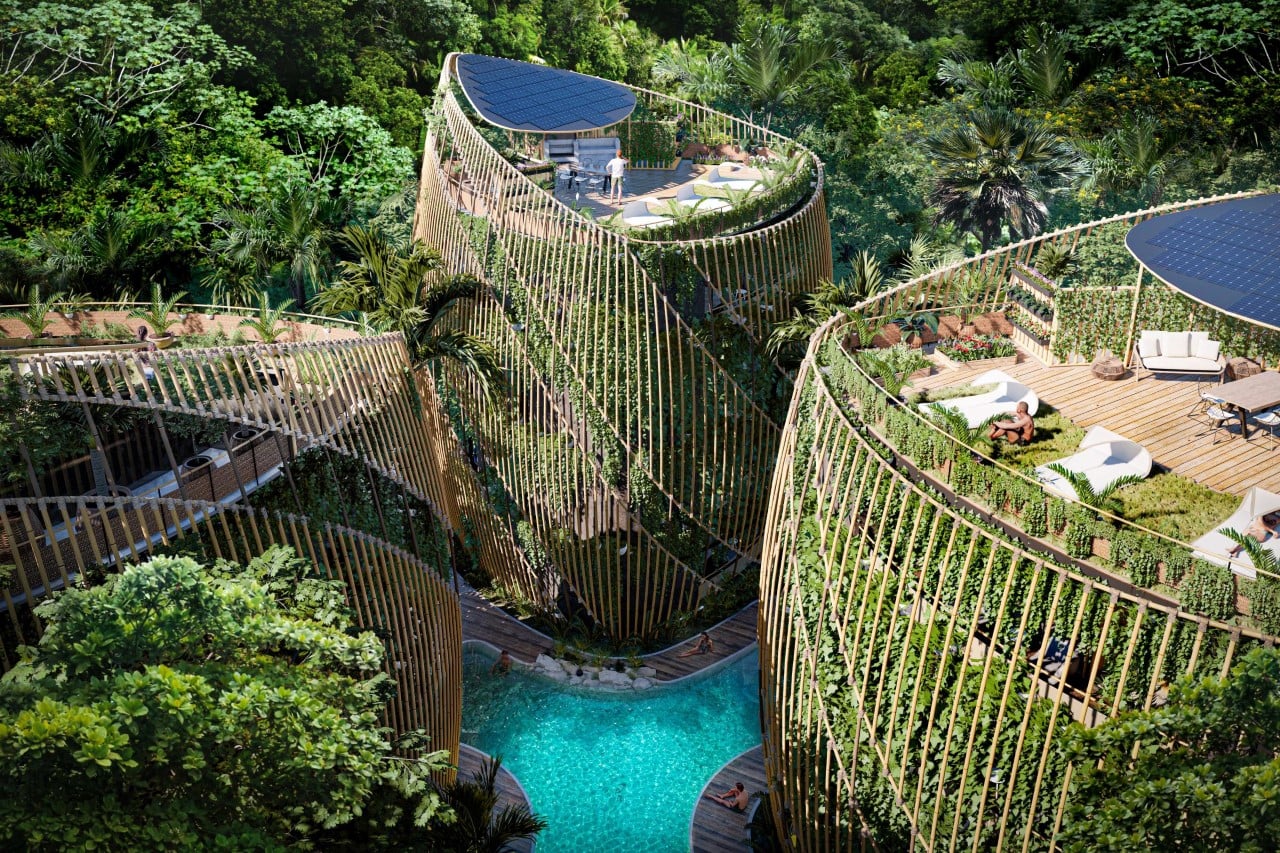
Goethe’s words “I call architecture frozen music” couldn’t ring more true for these 8 structural marvels. If architecture truly is frozen music, this article is a mixtape of 2020-21’s greatest hits.
A part of A’ Design Award and Competition‘s winner list, these buildings are awarded for the uniqueness of the project, social impacts, environment friendliness, energy utilization, and other project-specific criteria. Ranging from conceptual designs to residential units, to spas, offices, museums, and retail spaces, the A’ Design Award covers architecture in its entirety, aside from a wide roster of other categories. Not only does winning an A’ Design Award look great on an architect’s resume, but it also brings a lot of repute and focus to the work, uplifting its value!
Architecture remains the most popular category at the A’ Design Awards, receiving entries by the thousands each year. Here are a few favorites that we wish we had enough money to afford!
The A’ Design Award is currently accepting entries for the 2022 edition of the award program, so go ahead and give your work and career the push it deserves!
If you’re an architect or spatial designer looking to participate in the A’ Design Awards this year, click here to register. Hurry! The regular deadline ends on September 30th, 2021.
Living The Noom by Sanzpont Arquitectura
 Designed by Mexico-based Sanzpont Arquitectura, ‘Living In The Noom’ puts you in the lap of nature and luxury. Its sanctuary-esque design focuses on three broad pillars – Wellness, Sustainability, and Flexibility. The community features multiple 4-storeyed houses with a uniquely alluring triangular shape, characterized by vertical bamboo channels and a vertical forest growing on the outer facade of the building. Along with giving Noom’s residents a stellar home to live in, the project even comes with amenities like greenery (70% of the project’s area is covered in nature – the buildings occupy just 30% of the overall space), as well as rejuvenation centers, meditation areas, parks, pools, workshop-centers for art, and even the organic garden for healthy eating. Finally, the structure culminates in a terrace on the fifth floor that has solar panels for harvesting energy, and an urban garden where the residents can grow their own food.
Designed by Mexico-based Sanzpont Arquitectura, ‘Living In The Noom’ puts you in the lap of nature and luxury. Its sanctuary-esque design focuses on three broad pillars – Wellness, Sustainability, and Flexibility. The community features multiple 4-storeyed houses with a uniquely alluring triangular shape, characterized by vertical bamboo channels and a vertical forest growing on the outer facade of the building. Along with giving Noom’s residents a stellar home to live in, the project even comes with amenities like greenery (70% of the project’s area is covered in nature – the buildings occupy just 30% of the overall space), as well as rejuvenation centers, meditation areas, parks, pools, workshop-centers for art, and even the organic garden for healthy eating. Finally, the structure culminates in a terrace on the fifth floor that has solar panels for harvesting energy, and an urban garden where the residents can grow their own food.
Flowers of Clouds Observation Tower by Vu Van Hai
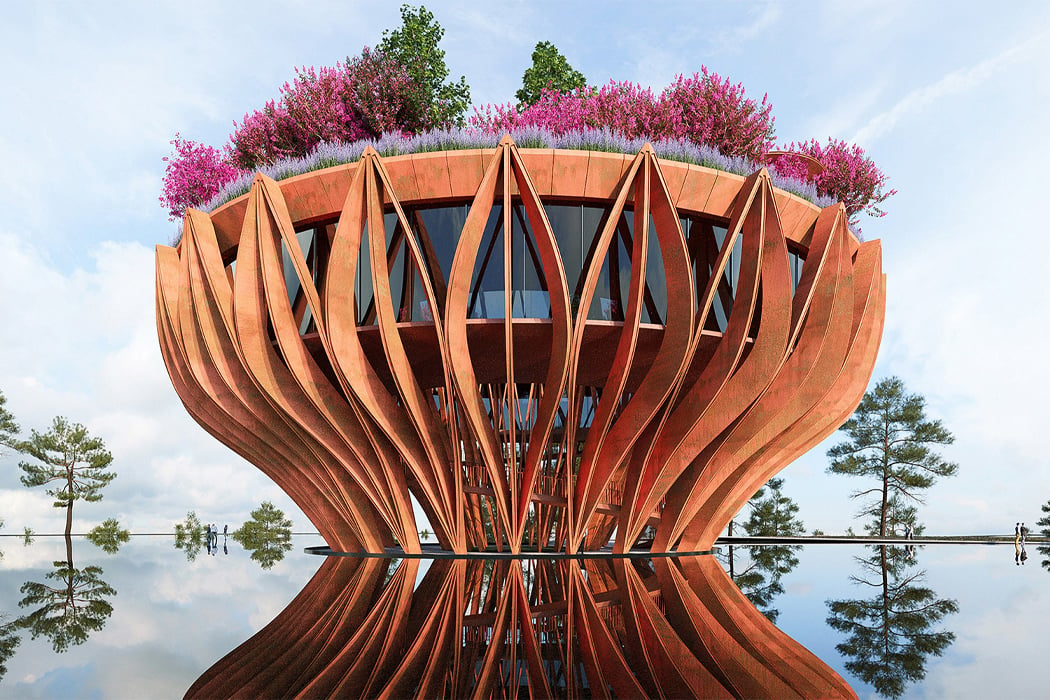
Characterized by its rolling hills coated with pine trees, marigolds, and mimosa flowers, Da Lat is considered one of Vietnam’s most romantic cities. The Tower Flower, an observation tower molded into the shape of a flower in the early stages of blooming, sings an ode to those rolling hills of Da Lat with terrace gardens and biophilic design principles. Designed to be a coffee boutique bar as part of a larger resort complex, The Tower Flower’s spherical frame features facades that mimic flowers blooming with rich orange corten steel modules that form the structure’s large petals. Twisting throughout the building’s interior, a winding ramp emulates the flow and curve of a river to allow the surrounding landscape and interior garden to gradually appear to each guest and visitor. Inside the coffee boutique bar, visitors and residents can enjoy views of the surrounding landscape as well as the structure’s interior garden that pays tribute to the Lotus flower, the symbol for pure beauty in Buddhism.
Time Holiday Mobile Home by Chester Goh
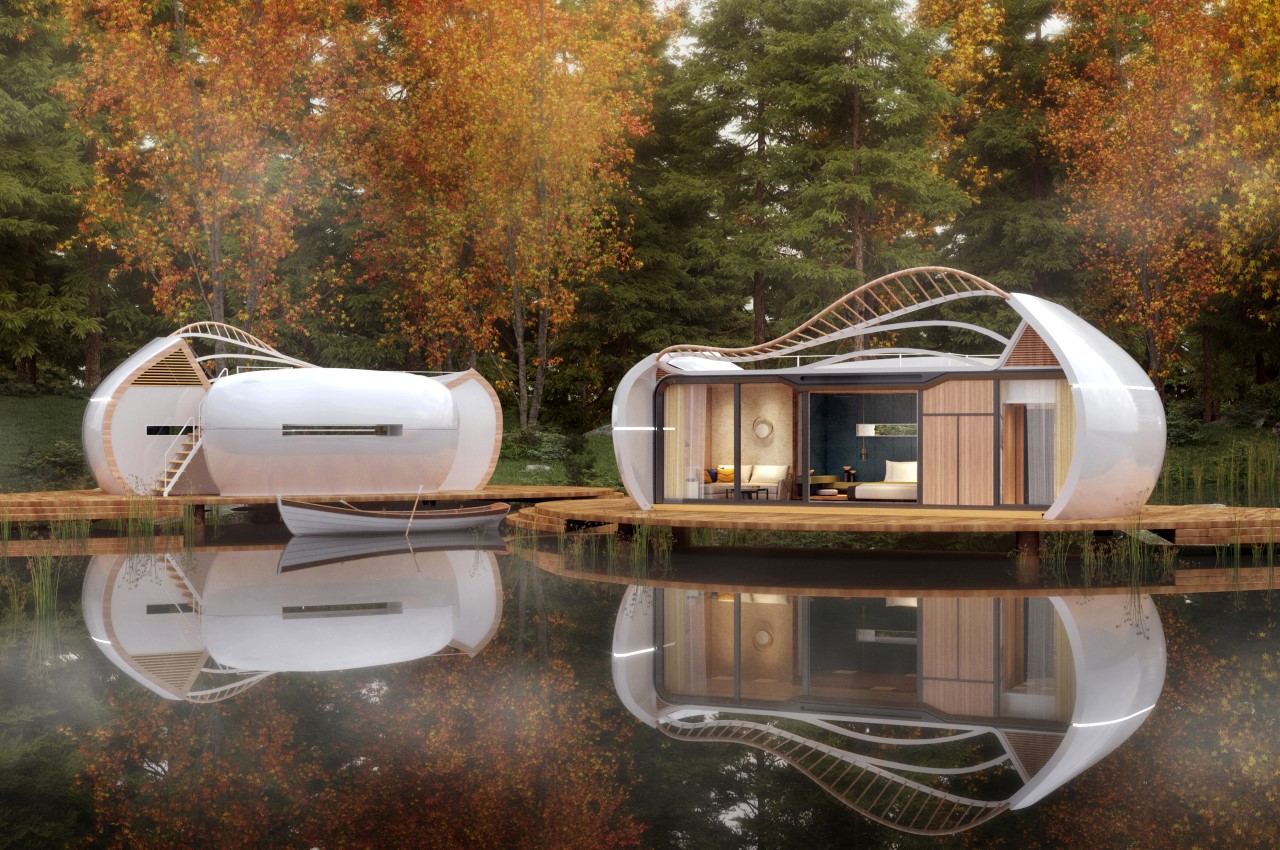 Designed so that you can have a cabin in the woods, a house on the lake, or a property on the beach whenever you want, the Time Holiday is a mobile home that’s focused on what designer Chester Goh calls ‘futuristic sustainability… or basically architecture that’s nomadic, so you don’t need to build multiple homes. Saving on total costs and unnecessary construction waste, these modular pods/villas come prefabricated and do not require any foundation. They’re built to be stable, spacious, and structurally sound, and can easily be lifted up and shifted anywhere on the planet without any limitations to terrains and topography. “Wanting to wake up to the morning of serene blue sea, lush green grassland, or a majestic golden dessert in a modular pod that is closely connected to nature has been the driving inspiration to this project”, says designer Chester Goh.
Designed so that you can have a cabin in the woods, a house on the lake, or a property on the beach whenever you want, the Time Holiday is a mobile home that’s focused on what designer Chester Goh calls ‘futuristic sustainability… or basically architecture that’s nomadic, so you don’t need to build multiple homes. Saving on total costs and unnecessary construction waste, these modular pods/villas come prefabricated and do not require any foundation. They’re built to be stable, spacious, and structurally sound, and can easily be lifted up and shifted anywhere on the planet without any limitations to terrains and topography. “Wanting to wake up to the morning of serene blue sea, lush green grassland, or a majestic golden dessert in a modular pod that is closely connected to nature has been the driving inspiration to this project”, says designer Chester Goh.
Shenzhen Transsion Holdings Office by Aedas

The terms ‘natural’ and ‘boxy’ don’t often go together, except with buildings like the Shenzhen Transsion Holdings office, where they’re made to combine together in a nature-meets-architecture solution. The building’s rather template-ish skyscraper design is beautifully punctuated by greenery that creates a feeling of ‘openness’ within the confines of the architecture. These intermediate ‘open spaces’ create variety and interactions between the staff and offices, to demonstrate the corporate spirit of “co-operation and co-sharing” through symbolic architecture… I’d call it a rather literal interpretation of being in a ‘concrete jungle’!
Bayfront Pavilion by Thomas Schroepfer – AAL

The inspiration for the Bayfront Pavilion was the visually beautiful experience of walking under the foliage of lush trees in the tropics. This idea was translated into a design with a clear mathematical logic that was determined by extensive environmental simulations and structural optimizations, resulting in an artificial canopy that still felt natural as you walked underneath it. Light filtered through the canopy’s perforated design – a phenomenon the Japanese call Komorebi – and as the canopy cut out a major chunk of sunlight, the area underneath was naturally cooled by the shade. Located in Gardens by the Bay Singapore, the Bayfront Pavilion (also known as The Future of Us Pavilion) follows the tradition of architectural structures that evoke a dialogue with nature by blending an intricate form made of a perforated skin fluidly with the adjacent environments. For visitors, the building offers a climatically comfortable outdoor environment and a visual experience akin to walking under the foliage of lush tropical trees.
The Rossmore Residential Multi-Unit by Artur Nesterenko and Amr Samaha

A beautiful interpretation of art-deco architecture, the Rossmore residential building turns concrete into fabric with how it curves, almost like the curtains seen in theaters. The concrete pillars curve and pleat as they travel downwards, mimicking fabric curtains seen in grand halls built during the art-deco era. “The Rossmore is set to utilize high-performance concrete cladding panels with sculptural elements for the facades while being one of the first massive timber mid-high-rise apartment buildings in Los Angeles”, say the designers.
Nudibranch Hotel and Resort by SpActrum
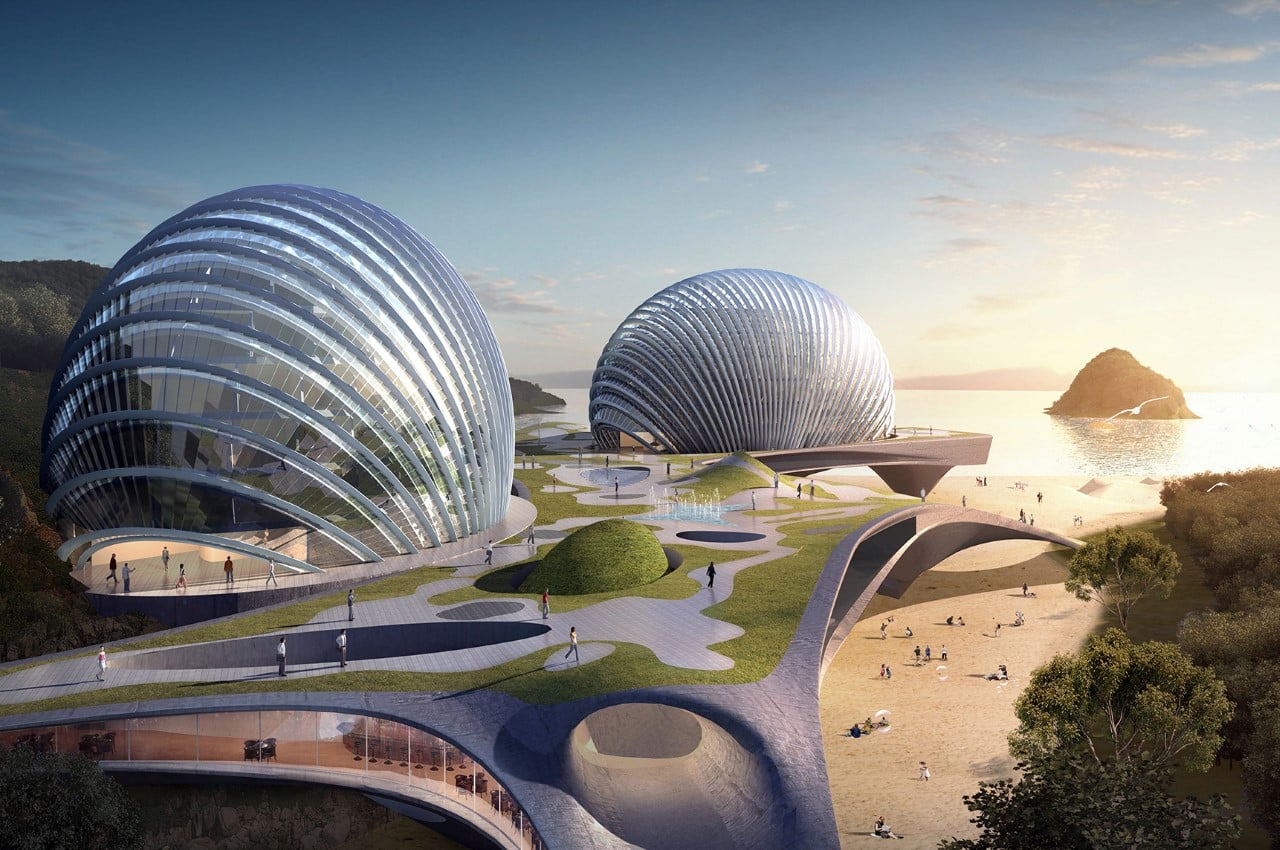
Inspired by shellfish, the Nudibranch hotel comes with an instantly recognizable shell-like facade, and has ‘tentacles’ that stretch out in different directions, creating a piece of architecture that looks absolutely mesmerizing from any angle. Named after the nudibranch, a type of mollusk, the hotel stands as a wonderful example of nature-inspired design. The ‘shell’ of the hotel forms its main building, while the rest of its body surrounds the shell, forming lawns and pathways above the sandy coast of the beach. The tentacles (which aren’t visible in the above image) are actually covered pathways that connect the ground to restaurants and bars, and the spa and swimming pool to the main hotel itself.
Solar Veloroute Photovoltaic Pathway by Peter Kuczia
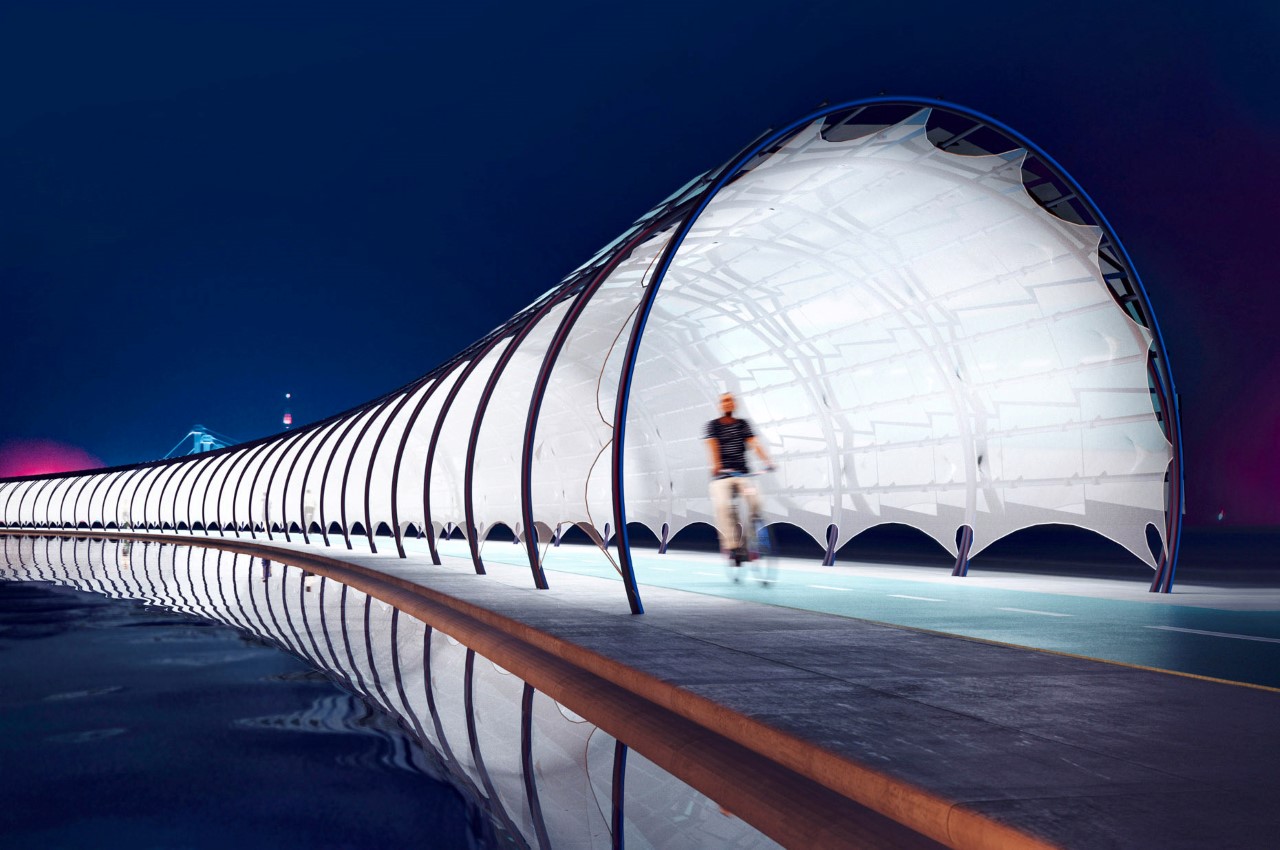
Bike roads, also known as Veloroutes are steadily becoming city staples, even mainstays for commuters on foot or bike. With the demand for Veloroutes increasing, Kuczia created a Solar Veloroute that comprises a photovoltaic tunnel structure that serves as a solar canopy for cyclists and pedestrians as well as a public facility where commuters can enjoy lit pathways at night and charging stations for bicycles or smartphones. Solar Veloroute presents as a partly-enclosed, rounded archway constructed from overlaid non-reflective glass-glass solar panels, which are attached to round tube steel purlins. While the Solar Veloroute collects solar energy during the day for on-site charging stations and lighting, the surplus energy collected can be distributed and used for additional services. On the structure’s sustainably sourced power, Kuczia says, “Just one kilometer of [Solar Veloroute] could provide around 2,000 MWh of electricity and could power 750 households or provide electricity for more than 1,000 electric cars driving 11,000 km per year.”
If you’re an architect or spatial designer looking to participate in the A’ Design Awards this year, click here to register. Hurry! The regular deadline ends on September 30th, 2021.
via https://ift.tt/2nqSsIm
Post a Comment
Note: Only a member of this blog may post a comment.